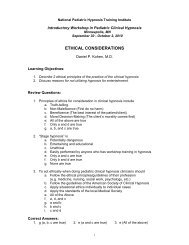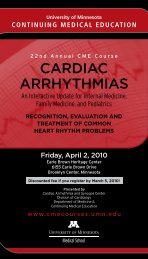Managing CVA in ED Learning Objectives Is it a stroke? Diagnosis ...
Managing CVA in ED Learning Objectives Is it a stroke? Diagnosis ...
Managing CVA in ED Learning Objectives Is it a stroke? Diagnosis ...
You also want an ePaper? Increase the reach of your titles
YUMPU automatically turns print PDFs into web optimized ePapers that Google loves.
<strong>ED</strong> evaluation<br />
• In<strong>it</strong>ial same as other <strong>CVA</strong><br />
• Anatomy best def<strong>in</strong>ed w<strong>it</strong>h MRI/MRA or<br />
CTA<br />
• Treatment (same)<br />
In patients dizz<strong>in</strong>ess or vertigo or<br />
HA w<strong>it</strong>h accompany<strong>in</strong>g neuro<br />
symptoms – posterior circulation<br />
vascular disease must be ruled<br />
out<br />
Summary<br />
• Evolv<strong>in</strong>g treatment options make pace of <strong>CVA</strong><br />
workup and treatment important<br />
• CT still gold standard but CTA and MRA add<br />
important vessel anatomy def<strong>in</strong><strong>it</strong>ion<br />
• TIA’s are high risk events; understand<strong>in</strong>g and<br />
communication are cr<strong>it</strong>ical<br />
• Reperfusion strategies improve outcomes <strong>in</strong><br />
selected patients<br />
• Posterior <strong>CVA</strong>’s are difficult to diagnose and<br />
must be thought of and looked for<br />
References<br />
1. Stroke. 2003;34:1056-1083<br />
doi: 10.1161/01.STR.0000064841.47697.22<br />
2. http://www.aafp.org/afp/990515ap/2828.html<br />
3. Stroke. 1999;30:1440-1443<br />
4. http://www.americanheart.org/presenter.jhtmlidentifier=4724<br />
5. ACEP EMCREG Monograph: Advanc<strong>in</strong>g the Standard of Care<br />
Cardiovascular, Neurovascular, and Infectious Emergencies; Oct 2007<br />
10

















